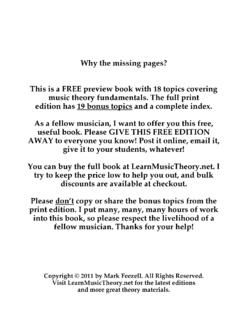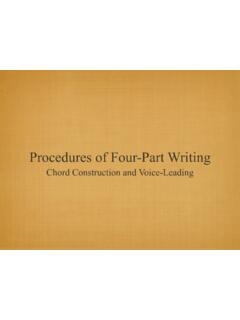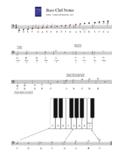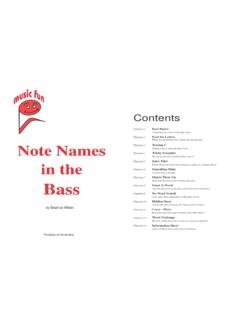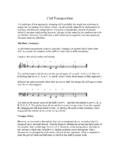Transcription of Music Theory Fundamentals - people.carleton.edu
1 1 Music 208 Winter 2014 John Ellinger, Carleton CollegeMusic Theory FundamentalsPitchPitch refers to how high or low a note RangesPitch ranges are often referred to in terms of the human singing voice. Soprano, a high woman's voice Alto, a low woman's voice Tenor, a high man's voice bass , a low man's voiceMusic StaffMusic is written on a Music staff that consists of five lines and four can refer to the lines and spaces as plural of staff is staves. Staves are often connected by a brace or bracket and bar And SpacesNotes can be drawn on a line or a space. A note on a line is centered on the line. A note in a space is contained within the space between the hand written Music be careful to center notes on the line or draw them completely within the space.
2 Otherwise, the note is ambiguous. Are the following two notes on lines or spaces?Ledger LinesLedger lines are used to extend the range of the staff. Ledger lines can appear above or below the staff. They maintain the spacing of the staff lines and extend slightly beyond each note head. Ledger lines never extend 3further than necessary. Low / HighThe higher up the staff the note appears, the higher the AlphabetThe musical alphabet consists of the letters A B C D E F G. Each letter corresponds to a specific line or space on the staff. As you move forward through the musical alphabet the pitch of each note gets higher. You could arbitrarily assign any staff line or space to represent the note A.
3 The names of the other lines and spaces would follow from clef symbol is placed at the beginning of each staff to fix the location of a specific pitch on a specific staff line. The two most common clefs are the Treble and bass clefs. 4 When we put clefs into the example given earlier we get the musical alphabet from A to G in each of these four Of ClefsClefs are chosen to match the range of a voice or an instrument so that the majority of notes fall within the these notes are notated in treble clef many ledger lines are necessary. However, they fit nicely in the bass ClefTreble clef is part of a family of clefs known as G clefs. The curl in the treble clef symbol locates the note G on the names of notes on the lines of the treble clef (EGBDF) can be remembered by the sayingEvery Good Boy Does Fine or Elvis' Guitar Broke Down names of notes on the spaces of the treble clef (FACE) spell the line and space notes are combined, they form the musical that use the treble clef include the piano (right hand), violin, flute, trumpet, and ClefThe two dots in the bass clef symbol locate the line that represents the pitch F.
4 Because it defines the pitch F, the bass clef is referred to as a F names of notes on the lines of the bass clef (GBDFA) can be remembered by the sayingGood Boys Do Fine AlwaysThe names of notes on the spaces of the bass clef (ACEG) can be remembered by sayingAll Cows Eat Grass or All Cars Eat the line and space notes are combined, they form the musical that use the bass clef include piano (left hand), cello, bassoon, and KeyboardThe piano keyboard consists of 88 keys arranged in repeating groups of white keys and black keys. Low notes are on the left side of the piano keyboard. High notes are on the right side of the piano keyboard. As you move from left to right on the piano, the pitch of each note gets Key GroupsThe black keys of the piano are arranged in groups of twos and threes.
5 Using these black key groups you can identify any note on the keyboard. For example, C is always the white key immediately to the left of a two black key group, and A is always between the second and third black key in a three black key White KeysThe white keys on the piano correspond to the musical alphabet A B C D E F G. You can always locate the note A on the piano by finding a group of three black keys and then playing the white key between between the second and third black key. Then names of the other white keys follow from 7there. The musical alphabet is repeated a little over seven times on the white keys of the piano CMiddle C is the C that is found in the middle of the piano keyboard.
6 Pitch, Clefs, Staff, And Keyboard CombinedIn each clef there is an exact correlation between the letters of the musical alphabet, the notes on the staff, and the piano white keys. As the pitch of each note rises, you move forward through the musical alphabet, you move to the right on the piano, and you move up on the musical staff. Notice that each letter name has its own white key on the piano and its own corresponding place on the Music clef Range On The Piano8 bass clef Range On The StepsThe half step is the smallest unit of pitch used in Western Music . Half steps occur naturally on the piano between any two adjacent piano keys, white to black, black to white, or white to Occurring Half Steps (Nohs)Two half steps occur naturally in the musical alphabet A B C D E F G, between B-C and E-F.
7 They are referred to as Naturally Occurring Half Steps, NOHS. On the piano they are the white keys pairs that do not have a black key between StepsTwo consecutive half steps make a whole step. Whole steps occur on the piano between the first and third key of any three adjacent piano keys, white to white, black to black, white to black, or black to - F#White - BlackBb - CBlack - WhiteD - EWhite - WhiteGb - AbBlack - Black10 Naturally Occurring Whole Steps (Nows)Whole steps occur naturally on the piano white keys, and in the musical alphabet A B C D E F G, between every letter pair except B-C and E-F. There are five pairs of naturally occurring whole steps: A-B, C-D, D-E, F-G, and Recognition Of Whole Steps And Half StepsNotice that it's impossible to visually distinguish whole steps and half steps on a Music staff without a need to know the clef in order to know where B-C and E-F interval is the distance between two notes.
8 The size of an interval is measured in half steps. The size of a half step is one half step. The size of a whole step is two half important interval is the octave. An octave is the interval between two notes that have the same name and are twelve half steps apart. If you start on any note of the piano and then play twelve successive half steps up or down you'll reach the note that has the same name as the one you started from. Those two notes are an octave apart. The root "oct" refers to the fact that an octave spans eight alphabet letters. An 88 key piano has a range of seven and a half octaves. We'll be studying more about intervals in Unit are symbols that alter the pitch of a note.
9 Five accidentals are used in Music notation: the flat, sharp, double flat, double sharp, and pitch by half stepSharpraises pitch by half stepDouble Sharpraises pitch by whole stepDouble Flatlowers pitch by whole stepNaturalcancels previous accidentalIn Music notation accidentals precede the note they affect. However, in speaking or text the accidental follows the note name. You say or write "G sharp" or "G#", not "sharp G."Single AccidentalsSingle accidentals raise or lower the pitch of a note by a half step. They are are the sharp, flat, and natural. Single accidentals are very common in AccidentalsDouble accidentals raise or lower the pitch of a note by two half steps or one whole step.
10 They are are the double sharp and double flat. Double 13accidentals are much less common than single natural is used to cancel a previously used sharp or flat. The following example illustrates an important musical : Once an accidental is used within a measure it remains in effect until you reach the end of the measure or it is altered by another And Keyboard Black KeysMost, but not all, accidentals that appear in a piece of Music are played on the black keys of the piano. The key immediately to the right (higher pitch) of any white key is called that key sharp. For example, the black key immediately to the right of D is called D#.The key immediately to the left (lower pitch) of any white key is called that key flat.
